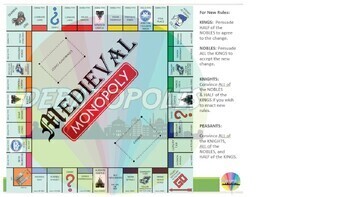Medieval Monopoly - Feudalism Lesson
- PPTX
What educators are saying
Description
Teach Feudalism in a fun interactive way with this Medieval Monopoly Game! Assign each of your students to a group playing the role of a king, noble, knight, or peasant. Kings, of course, have more money to buy property and more power to change the rules of the game. While peasants, though many in number, have very little power and money, often leading them to stealing or even revolting. Watch your classroom turn into a Middle Ages economic system and enjoy the sociological experiment unfold before you.
Helpful Tips: Use your own monopoly game for the cash. Download the medieval themed property and chance cards. Ideally you would project the game board on a whiteboard and use magnets as your different game pieces. Write with a dry erase marker as students buy different property. Write new laws proposed on the white board as well. Use large classroom dice to make it more fun!
For class sizes of 20 students use: 2 kings, 4 nobles, 6 knights, 8 peasants. Adjust accordingly.
Follow the rules provided in your download. Examples for new laws that can be proposed by student players: Kings receive $200 every time a six is rolled. Or every time Peasants roll a 3, they must sing a medieval song, do jumping jacks, etc. This will allow your creative students to thrive.
In the end, students will learn how feudalism was not healthy for a society. Power and money often corrupts and is used selfishly. There was very little mobility between social classes in this time, and therefore little incentive to work hard and invent new ideas. It can also help students learn some empathy for peasants and the poor members of society.


